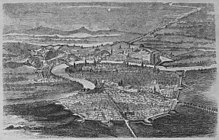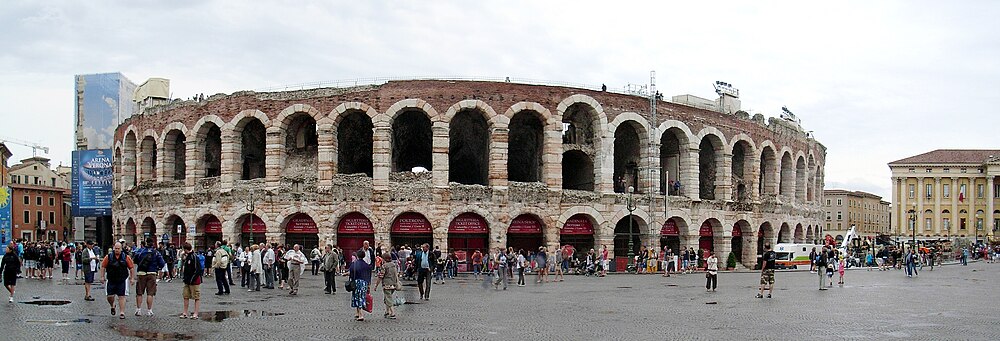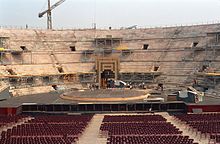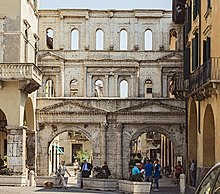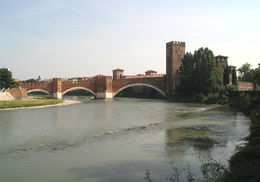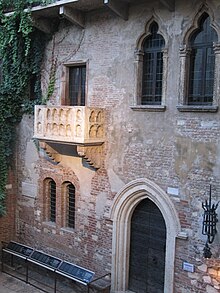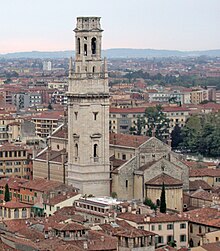Verona
| Verona | ||
|---|---|---|
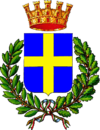
|
|
|
| Country | Italy | |
| region | Veneto | |
| province | Verona (VR) | |
| Local name | Verona | |
| Coordinates | 45 ° 26 ' N , 11 ° 0' E | |
| height | 59 m slm | |
| surface | 206.63 km² | |
| Residents | 259,608 (Dec. 31, 2019) | |
| Population density | 1,256 inhabitants / km² | |
| Post Code | 37000-37999 | |
| prefix | 045 | |
| ISTAT number | 023091 | |
| Popular name | Veronesi | |
| Patron saint | San Zeno | |
| Website | www.comune.verona.it | |
Verona is a city in the region Veneto in northeastern Italy . It has 259,608 inhabitants (as of December 31, 2019) and is the capital of the province of Verona . Verona lies on the Adige about 59 m above sea level at the outlet of the Adige Valley and the Brenner transit route into the Po plain . The old town of Verona has been a UNESCO World Heritage Site since 2000 .
history
Verona was founded by the Raetians and Euganeans , was founded around 550 BC. Conquered by the Gallic tribe of the Cenomani and was only from 89 BC. BC Roman colony . The well-preserved amphitheater - the Arena di Verona - was not built until more than a century later.

It was not until the colony of Emperor Augustus that Verona became a large city. Decius defeated Emperor Philip Arabs here in 249 , and Constantine defeated Pompeian in 312 ( Battle of Verona ). In 402 Stilicho managed to defeat Alaric ( Battle of Verona ). Attila looted and ravaged the city in 452. Then, next to Pavia and Ravenna, it was the residence of the Ostrogoth king Theoderic , who had defeated Odoacer here in 489 and is called Dietrich von Bern in the legend . The old name of the city comes from this time: " Dietrichsbern ". Furthermore, the name " Welsch-Bern " was used in old times ( Cimbrian : Bearn ).
In the 5th and 6th centuries Verona was not only the residence of the Ostrogoths, but also for the Lombard king Alboin , until it came to the Frankish Empire. As a result of the devastating Hungarian invasions in northern Italy from 899 onwards , the heavily fortified city became a mint after 900 , which became the starting point of the Veronese currency area . From 952 Verona belonged to the Margraviate of Verona and thus to the Duchy of Bavaria and / or (from 976) to Carinthia . It was not until the beginning of the 12th century that Verona became independent and had its own city rights . In 1184 the Council of Verona took place.
In the fight against Emperor Frederick I , Verona was at the head of the Lombard League of Cities . Then it was shaken by the party struggles of the aristocratic parties, the Montecchi ( Ghibellines ) and the San Bonifazios ( Guelphs ). At the beginning of the 13th century the Ezzelini, the protectors of the Montecchi, seized the city. After the death of Ezzelinos da Romano (1259), the Veronese elected Mastino I della Scala as head ( Podestà ) in 1260 , whose family ruled for 127 years and reached their highest power and prosperity under Cangrande I della Scala .
In 1387 Verona came under the rule of Milan , in 1405 under the rule of Venice . After the end of the Republic of Venice, Verona went to Austria in the Peace of Campo Formio in 1797 ; the previous anti-French uprising of the Veronese at Easter was bloodily suppressed. Under Austrian rule, the city was part of the northern Italian fortress quadrilateral (it .: Quadrilatero ), which was built in 1815 to defend the Austrian possessions in Italy in the places Peschiera , Mantova (Mantua) , Legnago and Verona. The expansion was carried out between 1833 and 1866 according to plans by the engineer general Franz Scholl . In 1866 Verona came to the Kingdom of Italy as a result of the German War .
Today the city is a popular destination for tourists and the economic center of the Veneto region due to its proximity to Lake Garda and Venice . In 2000 the old town of Verona was added to the UNESCO World Heritage List .
Roman Verona
Several monuments still bear witness to the importance of Verona as a political and economic center, from the arena to the Roman theater, from the Gavi arch to the Porta Borsari city gate, from the excavation area of the Porta Leoni to the Scavi Scaligeri.
arena
The well-preserved amphitheater , which has been incorporated into today's cityscape, was probably built under Emperor Tiberius around 30 AD. It was built half a century before the Colosseum in Rome (80 AD) and is therefore one of the earliest examples of an amphitheater in the form of a closed oval, which was further developed by the Romans. The structure is 138 m long, 109 m wide and is the second largest amphitheater next to the Colosseum in Rome in terms of conservation status. The classically structured facade consists of two-storey arcade arches; you have to imagine the original with an additional outer wall made of pink marble. The inside of the arena consists of 45 rows of seats, which are 45 cm high and 45 cm deep, with around 22,000 seats today. In summer the famous opera festival takes place in the arena.
The arena is surrounded by the Piazza Bra with the paved Listone built in 1730. The wide sidewalk with many restaurants runs in front of the facades of the palazzi on the west side of the square.
Arco dei Gavi
On the way from the Ponte Scaligeri into the city - on a square facing the Adige at the end of Corso Cavour - the first thing you pass is the Arco dei Gavi. Originally it was not far from the clock tower of the nearby Castelvecchio and was later included in the city wall ring. The Roman arch of honor dates from the 1st century AD. In 1805 the French tore the monument down. The rubble was only rediscovered in 1932 and reassembled according to an elevation drawing.
Porta dei Borsari
Other architectural monuments from ancient times are the former city gates Porta dei Borsari and Porta dei Leoni and the remains of a Roman theater . The three-storey, monumentally designed Porta Borsari, it once opened to the Roman road Via Postumia, was built in 265 AD under Emperor Gallienus and is the best preserved Roman monument after the amphitheater.
Medieval center
Castelvecchio and Ponte Scaligero
The Castelvecchio of the Lords della Scala on the Adige , built by Cangrande II della Scala from 1354 to 1356, and the fortress bridge crowned with battlements are architectural masterpieces. The purpose of the fort and the Ponte Scaligero was to secure the escape route of the Scaliger to the other bank of the Adige. At the time of its completion in 1356, the three-arched Ponte Scaligero was the largest segment arch bridge in the world with a main span of almost 49 m . The castle now houses a museum with works of Veronese painting and sculptures from the Middle Ages.
On Corso Cavour, between Castelvecchio and Porta Borsari, which is then called Corso Castelvecchio up to Porta Nuova, there are a number of palaces worth seeing. The Museo Civico di Storia Naturale (Natural History Museum) is housed in the Palazzo Scannagatti (1530 to 1537).
Piazza delle Erbe

Historic facades from different centuries surround the Piazza delle Erbe, market square and meeting place of the medieval city republic. On the narrow side of the square opposite the passage to Piazza dei Signori are the massive Palazzo Maffei from 1668, reminiscent of Roman baroque buildings, and the medieval clock tower Torre del Gardello from the 14th century. In front of it rises a marble column with the winged lion of St. Mark . The medieval town houses of the Casa dei Mazzanti with their frescoes border the square to the east. In the center, the “Madonna Verona”, which soon after its construction in the 14th century became a symbol of the city, towers over an ancient fountain.
From the Piazza delle Erbe it is only a few steps to Juliet's house (Casa di Giulietta) with the most famous balcony in literary history. For the characters in the play Romeo and Juliet by Shakespeare , there was no historical models and no Juliet's house. The balcony was retrofitted in the 1930s and was previously part of a sarcophagus. What is now available for inspection as Juliet's house is the remnant of a large palatial building that was owned by the dal Capello family in the 14th century, who were identified with the Capulets (Montagues and Capulets). Before the renovation, however, the house had been used as an inn and partly as a stable.
Piazza dei Signori
With fortified private palaces, the Scaliger had built around the Piazza dei Signori with the monument to Dante (by Zannoni). If you come from the Piazza delle Erbe, you pass the Palazzo dei Giudici. The Venetian judges once held their office in the 17th century building. To the right are the Romanesque Palazzo del Comune from 1194 with the 83 m high Torre dei Lamberti and the Palace of Justice from 1365.
The opposite narrow side of the piazza is occupied by the Palazzo del Governo with its crenellated crown. The provincial government is now located where the Scaliger once resided. Right next to the gloomy Gothic palaces of the fallen Scaliger, the new lords from Venice built their beautiful Renaissance loggia Fra Giocondo after taking power in the 15th century.
Sacred buildings
San Zeno Maggiore
The Basilica of San Zeno Maggiore is a Romanesque building from the eleventh and twelfth centuries. The tower of the abbey and the tower of the basilica form an appealing frame for the facade of the church, which impresses with its impressive coloring, harmonious architectural style and simple decorations. The large rose window above the building and sculpture complex in the entrance area is particularly appealing . The church of San Lorenzo , which also dates from the eleventh and twelfth centuries, is set back in the middle of these historical facades . It is a Romanesque gallery basilica with five apses that emerged from a previous Carolingian building . In the three-aisled interior, almost nothing of the original furnishings has been preserved, as the church was badly damaged in the Second World War.
Cathedral of Santa Maria Matricolare
The cathedral Santa Maria Matricolare was consecrated in 1187 and combines both Romanesque and Gothic elements. Most famous is the portal by Nicolò with its contemporary Romanesque stone carvings; In the interior there are the frescoes from 1500, the altar painting by Titian and the Romanesque baptistery built from 1122 to 1135. Next to the choir part of the cathedral, a door leads to the baptistery of S. Giovanni in Fonte . In the three-aisled basilica there is the famous Romanesque baptismal font, carved from a single pink marble monolith.
San Fermo Maggiore
San Fermo Maggiore is a Gothic church with a beautiful wooden ceiling and a Romanesque crypt. The construction was started by Benedictine monks in 1065 and completed in 1138. The facade shows both Romanesque and Gothic style elements.
Sant'Anastasia
The Chiesa di Sant'Anastasia is the largest Gothic church in Verona. It was started by the Dominicans around 1290 and completed in 1481. Its facade was left unfinished.
The interior, divided into three naves by tall marble columns, is richly decorated. A colored floor and ornamental vault paintings characterize the picture. In addition to the grave monuments, altars and other sculptures from the 15th to 17th centuries, the famous fresco “Departure of St. George on the fight with the dragon ”by Antonio Pisanello (1433–1438). In the history of art it is considered to be the climax and end point of the courtly Gothic in Northern Italy.
Santa Maria Antica
Near the Piazza dei Signori is the small church of Santa Maria Antica from the 8th century. It was a kind of house church for the Scaligans . In addition, the family's private cemetery ( arche scaligere ) extends with magnificent Gothic tombs.
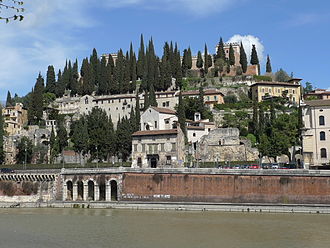
Museums
The Museo Lapidario Maffeiano is one of the oldest archaeological museums in Europe. It was set up in the first half of the 18th century by the Veronese writer Scipione Maffei and it shows Etruscan , Greek and Roman finds. The Museo Archeologico in the Teatro Romano houses a remarkable collection of Etruscan and Lower Italian bronzes as well as finds from Roman times. Changing photo exhibitions take place in the Scavi Scaligeri - an underground excavation site. In the Palazzo Forti there are regularly changing exhibitions on modern art. The Castelvecchio Museum is one of the most important art museums in Venice. It shows a collection of medieval sculptures and pictures. The Museo civico di Storia Naturale (City Museum of Natural History) in the Palazzo Pompei houses fossils as well as collections on mineralogy , geology , botany , zoology and folklore .
More Attractions
- Ponte Pietra : bridge from Roman times
- Santuario della Madonna di Lourdes: former Austrian fortress of San Leonoardo from the 19th century high above the city, converted into a pilgrimage church in the 1950s
- Porta dei Leoni: excavations from Roman times
- Arche Scaligeri : Tomb of the Scaliger
- Castel San Pietro: Castle above Verona
- Giardino Giusti: garden with a view of Verona
- Sante Teuteria e Tosca : Romanesque church with older buildings
- synagogue
climate
The climate of Verona is warm-temperate, but due to its location in the interior of the Po Plain, it is continental, so that frosts can occur more frequently in winter, especially in January and February. Summers are hot, occasionally it can reach over 37 ° C.
| Verona, Veneto | ||||||||||||||||||||||||||||||||||||||||||||||||
|---|---|---|---|---|---|---|---|---|---|---|---|---|---|---|---|---|---|---|---|---|---|---|---|---|---|---|---|---|---|---|---|---|---|---|---|---|---|---|---|---|---|---|---|---|---|---|---|---|
| Climate diagram | ||||||||||||||||||||||||||||||||||||||||||||||||
| ||||||||||||||||||||||||||||||||||||||||||||||||
|
Average monthly temperatures and rainfall for Verona, Veneto
Source: worldweather.wmo.int ; wetterkontor.de
|
|||||||||||||||||||||||||||||||||||||||||||||||||||||||||||||||||||||||||||||||||||||||||||||||||||||||||||||||||||||||||||||||||||||||
traffic
The Porta Nuova train station is an important railway junction; the Brenner railway Bologna - Innsbruck crosses the important line from Milan via the Milan – Venice railway to Venice .
Verona is also a hub of the Italian motorway network. The A22 Brenner motorway crosses European route 70 here . Verona Airport is located southwest of the city . Inner-city public transport is operated by buses from the Azienda Trasporti Verona. The main transfer points are Porta Nuova central station, Arena and Ospedale Maggiore.
Sports
The football club Hellas Verona played in the first ( Serie A ) and second ( Serie B ) Italian league and won the Italian championship in the 1984/85 season . In the 2005/06 season Verona played in Serie B, but rose after relegation. 2015/16 Hellas Verona rose again to the second Italian division. The smaller club Chievo Verona, on the other hand, played in Serie A from 2001 to 2007 and from 2008 to 2019. Both teams play their home games in the Stadio Marcantonio Bentegodi , which is located in the middle of a residential area not far from the main train station.
In 1999 and 2004 Verona hosted the UCI Road World Championships .
Personalities
Mayor of Verona is Federico Sboarina.
Famous personalities of the city are included in the list of personalities of the city of Verona .
Town twinning
Verona lists eight twin cities and 16 city friendships:
| city | country | Type | since |
|---|---|---|---|
| Albany |
|
Twin town | |
| Ayacucho |
|
City friendship | |
| Bethlehem |
|
City friendship | |
| Detmold |
|
City friendship | |
| Fresno |
|
City friendship | 2000 |
| Johannesburg |
|
Twin town | |
| Kazan |
|
City friendship | |
| Korça |
|
City friendship | |
| Corfu |
|
City friendship | |
| Košice |
|
City friendship | 1992 |
| Kragujevac |
|
City friendship | |
| Munich |
|
Twin town | 1960 |
| Nagahama |
|
Twin town | 1992 |
| Namwon |
|
City friendship | 2008 |
| Nîmes |
|
Twin town | 1960 |
| Ningbo |
|
City friendship | 2005 |
| Prilep |
|
City friendship | |
| Pula |
|
Twin town | 1980 |
| Ra'anana |
|
City friendship | 1998 |
| Saint-Josse-ten-Noode |
|
Twin town | |
| Salzburg |
|
Twin town | 1973 |
| Tirana |
|
City friendship | |
| Zhuji |
|
City friendship | |
| Zintan |
|
City friendship |
There are also partnerships with
literature
history
- Maureen Catherine Miller: The Formation of a Medieval Church. Ecclesiastical Change in Verona, 950-1150. Cornell University Press, 1993.
- Stefania Salti, Renata Venturini: La vita di Teodorico. Ravenna 2001.
- Luigi Simeoni: Studi su Verona nel medioevo. 3 volumes, Verona 1962.
- Andreas Stinsky: The 30 most famous archaeological sites on Lake Garda and in the surrounding area. With trips to Verona, Brescia, Bergamo and Trento . Nünnerich-Asmus-Verlag, Mainz 2018, ISBN 978-3-96176-016-9
- Giovanni Zalin: Storia di Verona. Caratteri, aspetti, momenti. Vicenza: Neri Pozza, 2001.
Art, architecture
- Andreas Bigelmair: Zeno of Verona. Munster 1904.
- Giorgio Borelli: Chiese e monasteri di Verona. Verona 1980.
- Federico Dal Forno: Case e palazzi di Verona. Verona 1973.
- Delia Fringesi: Cesare Lombroso. Turin, Einaudi, 2003, ISBN 88-06-13866-9
- Hans Dieter Huber: Paolo Veronese. Art as a social system. Fink, Munich 2005, ISBN 3-7705-3842-0 .
- Arturo Sandrini, Pierpaolo Brugnoli: L'architettura a Verona nell'età della Serenissima (sec. XV-sec. XVIII). Verona 1988.
- Arturo Sandrini, Pierpaolo Brugnoli: L'architettura a Verona dal periodo napoleonico all'età contemporanea. Verona 1994.
City walls
- Guido Barbetta: Le mura e le fortificazioni di Verona. Verona 1978.
Archival material
- Jürgen Klöckler: Prevented archival theft in Italy. Theodor Mayer and the “Archive Protection” department at the military administration in Verona 1943–1945. In: Sources and research from Italian archives and libraries . 86, 2006, pp. 491-537. ( online )
Web links
- Official website of the city of Verona
- Entry on the UNESCO World Heritage Center website ( English and French ).
- Verona on the ETHorama platform
Individual evidence
- ↑ Statistiche demografiche ISTAT. Monthly population statistics of the Istituto Nazionale di Statistica , as of December 31 of 2019.
- ^ Dietrichsbern . In: Herders Conversations-Lexikon . tape 5 . Freiburg im Breisgau 1857, p. 613 ( zeno.org ).
- ↑ Welsch-Bern . In: Brockhaus' Kleines Konversations-Lexikon . Fifth edition. tape 2 . Leipzig 1911, p. 969 ( zeno.org ).
- ↑ Fraud on the balcony
- ↑ In Juliet's courtyard - The legend of Romeo and Juliet
- ↑ Museo di Storia Naturale
- ↑ Comune di Verona - Grandi Eventi - Gemellaggi e Patti d'Amicizia . Retrieved April 24, 2018.
- ^ Chunhyangol Introduction to Namwon: Friendly Ties . Retrieved April 24, 2018.
- ↑ Jumelages . Retrieved February 24, 2017.
- ^ Sister city Verona - City of Salzburg . Retrieved April 4, 2017.
- ^ Verona (Italy) - Office for International Relations . Retrieved February 11, 2015.


